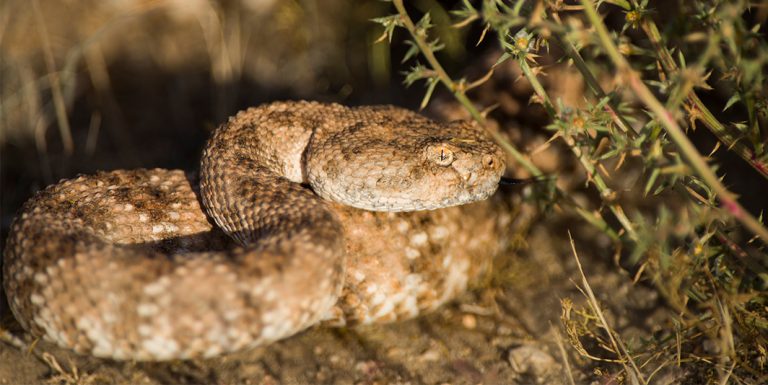
A dog had a fatal encounter with a rattlesnake at the Laurel Canyon Dog Park last week. A second was bitten but is recovering. These incidents highlight how important rattlesnake avoidance training is if you live in Southern California.
Michael Becker DVM, the vet at the Metropolitan Animal Specialty Hospital (MASH) in West Hollywood who treated the surviving dog, said it was the second incident so far this year. MASH usually treats 20 to 30 rattlesnake bites in the April to October rattlesnake season, he added.
A dozen park users met with a representative of the Los Angeles Department of Recreation and Parks on April 23. They discussed better signage, brush and grass clearance and snake-proof fencing. The recreation and parks department is proposing a rattlesnake barrier fence to be paid for by the department and expanded with community funding.
No barrier against rattlesnakes is perfect. That’s why training your dog to avoid rattlesnakes is better than relying on other safety measures.
Why is rattlesnake avoidance training better?
Dogs are especially vulnerable to snake bites. They follow their noses and keep their heads low and close to where snakes might be. The dogs that were bitten at Laurel Canyon Park on Monday, April 15, were both bitten on their heads. The one that died was bitten on the top of its head; the one that survived, Lili, was bitten on the chin.
Rattlesnake avoidance training exposes a dog to the smells and sounds of rattlesnakes in a controlled setting. The training uses muzzled, live snakes, baby snakes and shed skin and rattles. The trainer puts a shock collar on the dog before starting the training. When the dog alerts to the sight, sound or smell of the rattlesnakes, the trainer gives the dog a light shock. The goal is to teach the dog that something bad happens whenever he or she meets those sights, sounds or smells.
Young dogs learn to avoid rattlesnakes better than older dogs. The training needs to be repeated. It’s wise to repeat the training in different environments.
Once a dog has been trained, he or she should instinctively avoid rattlesnakes wherever he or she meets them — a dog park, on a hike or even your back yard.
Not all dogs can be trained
There is no perfect protection from rattlesnakes. And that includes rattlesnake avoidance training. I’ve done rattlesnake avoidance training with two dogs: Joey, a terrier mix; and Spike, a Shi Tzu-terrier mix.
Joey was older, probably about 11 years old, when he went through training. His hearing wasn’t very keen and his nose was losing its keenness. He didn’t alert strongly to the sound or scent of the snakes, but he did enough to get a shock. The trainers advised repeating the trainer later. They also made me aware that his training wasn’t strong so to be cautious and vigilant where rattlesnakes might be found.
Spike was a total flunk out. He nearly stepped on the baby snakes. He didn’t react to an angry rattle. In fact, he failed to react to the snakes. The trainer never could see a reaction to pair a shock to train Spike. At that point, we crossed hiking off our activity list.
Safety tips for avoiding rattlesnakes
Here are some tips for keeping your dog safe from rattlesnakes from the California Department of Fish and Wildlife:
- Be particularly alert to rattlesnake dangers in the months between April and October. In April, snakes are coming out of hibernation, heading for sunny rocks to warm on, shedding their skins and mating. On hot days, snakes will be most active at dawn, dusk or night.
- Be particularly careful in the hills or areas with tall grass, weeds or heavy underbrush where snakes may hide. Dr. Becker said that most dogs MASH treats for snake bite were walking in Griffith Park, Laurel Canyon Park or Runyan Canyon.
- If there’s a danger of rattlesnakes, keep your dog on a leash and stick to well-used trails.
- Never step or put your hands — or allow your dog to run — where you can’t see. Step on logs and rocks, not over them.
- Be aware that snakes can swim.
- Snakes are so widespread in Southern California that you can encounter one in your homes as easily as in the wild.
- Talk to your veterinarian about what to do if your pet is bitten. Many things we think we should do for a snake bite are wrong, including packing the bite in ice, cutting the area with a knife or razor or applying a tourniquet.
Sad facts
There were no “Caution rattlesnakes” signs up in Laurel Canyon Park before the two dogs were bit. If you love your dog, behave as if there are rattlesnakes around when you go out into hilly or wild areas with your dog whether there are signs or not.
Remember not all vet offices have rattlesnake anti-venom. Have a plan in case your dog gets bit. Lili, the surviving dog bit at Laurel Canyon Park, was taken first to one animal hospital for an anti-venom shot. That hospital didn’t have any more anti-venom, so Lili had to go to a second hospital, MASH.
If you found this post interesting, you might also like to read:
- Training dogs to avoid rattlesnakes, June 14, 2013.
- Rattlesnake dangers for LA dogs, June 13, 2013.